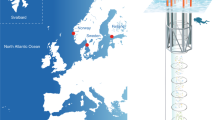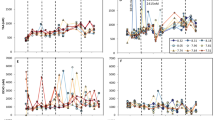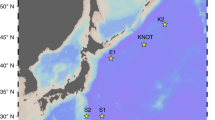Abstract
Anthropogenically released CO2 is dissolving in the ocean, causing a decrease in bulk-seawater pH (ocean acidification). Projections indicate that the pH will drop 0.3 units from its present value by 2100 (ref. 1). However, it is unclear how the growth of plankton is likely to respond. Using simulations we demonstrate how pH and carbonate chemistry at the exterior surface of marine organisms deviates increasingly from those of the bulk sea water as organism metabolic activity and size increases. These deviations will increase in the future as the buffering capacity of sea water decreases with decreased pH and as metabolic activity increases with raised seawater temperatures. We show that many marine plankton will experience pH conditions completely outside their recent historical range. However, ocean acidification is likely to have differing impacts on plankton physiology as taxon-specific differences in organism size, metabolic activity and growth rates during blooms result in very different microenvironments around the organism. This is an important consideration for future studies in ocean acidification as the carbonate chemistry experienced by most planktonic organisms will probably be considerably different from that measured in bulk-seawater samples. An understanding of these deviations will assist interpretation of the impacts of ocean acidification on plankton of different size and metabolic activity.
This is a preview of subscription content, access via your institution
Access options
Subscribe to this journal
Receive 12 print issues and online access
$209.00 per year
only $17.42 per issue
Buy this article
- Purchase on Springer Link
- Instant access to full article PDF
Prices may be subject to local taxes which are calculated during checkout


Similar content being viewed by others
Change history
07 September 2012
In the version of this Letter originally published, the unit on the right-hand y axis of Figure 2a and Supplementary Figures S3b, S5b, S7b, S9b and S11b should have read gC m−3. This error has now been corrected in the HTML and PDF versions of the Letter.
References
Caldeira, K. & Wickett, M. E. Anthropogenic carbon and ocean pH. Nature 425, 365 (2003).
Royal Society of London Ocean Acidification Due to Increased Atmospheric Carbon Dioxide Policy Document 12/05 (The Royal Society of London, 2005).
Doney, S. C., Fabrey, V. J., Feely, R. A. & Kleypas, J. A. Ocean acidification: The other CO2 problem. Annu. Rev. Mar. Sci. 1, 189–192 (2009).
Orr, J. C. et al. Anthropogenic ocean acidification over the twenty-first century and its impact on calcifying organisms. Nature 437, 681–686 (2005).
Steinacher, M., Joos, F., Frölicher, T. L., Plattner, G-K. & Doney, S. C. Imminent ocean acidification in the Arctic projected with the NCAR global coupled carbon cycle-climate model. Biogeosciences 6, 515–533 (2009).
Hinga, K. R. Effects of pH on coastal marine phytoplankton. Mar. Ecol. Prog. Ser. 238, 281–300 (2002).
Blackford, J. C. & Gilbert, F. J. pH variability and CO2 induced acidification in the North Sea. J. Mar. Syst. 64, 229–241 (2007).
Litt, E. J. et al. Biological control of p CO 2 at station L4 in the western English Channel over 3 years. J. Plankton Res. 32, 621–629 (2010).
Gypens, N., Lacroix, G., Lancelot, C. & Borges, A. V. Seasonal and inter-annual variability of air–sea CO2 fluxes and seawater carbonate chemistry in the southern North Sea. Prog. Oceanogr. 88, 59–77 (2011).
Santos, I. R., Glud, R. N., Maher, D., Erler, D. & Eyre, B. D. Diel coral reef acidification driven by porewater advection in permeable carbonate sands, Heron Island, Great Barrier Reef. Geophys. Res. Lett. 38, L03604 (2011).
Smith, F. A. & Raven, J. A. Intracellular pH and its regulation. Ann. Rev. Plant Physiol. 30, 289–311 (1979).
Raven, J. A. Exogenous inorganic carbon sources in plant photosynthesis. Biol. Rev. 45, 167–221 (1970).
Raven, J. A. Effects on marine algae of changed seawater chemistry with increasing atmospheric CO2 . Biol. Environ. Proc. R. Irish Acad. 111B, 1–17 (2011).
Kühn, S. F. & Köhler-Rink, S. pH effect on the susceptibility to parasitoid infection in the marine diatom Coscinodiscus spp. (Bacillariophyceae). Mar. Biol. 154, 109–116 (2008).
Kühn, S. F. & Raven, J. A. Photosynthetic oscillation in individual cells in the marine diatom Coscinodiscus wailesii (Bacillariophyceae) revealed by microsensor measurements. Photosynth. Res. 95, 37–44 (2008).
Milligan, A. J., Mioni, C. E. & Morel, F. M. M. Response of cell surface pH to p CO 2 and iron limitation in the marine diatom Thalassiosira weissflogii. Mar. Chem. 114, 31–36 (2009).
Hurd, C. L. et al. Metabolically induced pH fluctuations by some coastal calcifiers exceed projected 22nd century ocean acidification: A mechanism for differential susceptibility? Glob. Change Biol. 17, 3254–3262 (2011).
Mitra, A. & Flynn, K. J. Promotion of harmful algal blooms by zooplankton predatory activity. Biol. Lett. 2, 194–197 (2006).
Hofmann, A. F., Middelburg, J. J., Soetaert, K., Wolf-Gladrow, D. A. & Meysman, F. J. R. Proton cycling, buffering, and reaction stoichiometry in natural waters. Mar. Chem. 121, 246–255 (2010).
Hale, M. S. & Mitchell, J. G. Functional morphology of diatom frustule microstructures: Hydrodynamic control of Brownian particle diffusion and advection. Aquat. Micro. Ecol. 24, 287–295 (2001).
Engel, A., Thoms, S., Riebesell, U., Richelle-Newall, E. & Zondervan, I. Polysaccaride aggregation as a potential sink of marine dissolved organic carbon. Nature 428, 929–932 (2002).
Raven, J. A, Beardall, J., Giordano, M. & Maberly, S. C. Algal and aquatic plant carbon concentrating mechanisms in relation to environmental change. Photosynth. Res. 199, 281–296 (2011).
Taylor, A. R., Chrachri, A., Wheeler, G. L., Goddard, H. & Brownlee, C. A voltage-gated proton channel underlying pH homeostasis in calcifying coccolithophores. PLoS Biol. 9, e1001085 (2011).
Hansen, P. J., Lundholm, N. & Rost, B. Growth limitation in marine red-tide dinoflagellates: Effect of pH versus inorganic carbon limitation. Mar. Ecol. Prog. Ser. 224, 63–71 (2007).
Smith, M. & Hansen, P. J. Interaction between Mesodinium rubrum and its prey concentration, irradiance and pH. Mar. Ecol. Prog. Ser. 338, 61–70 (2007).
Eriksson, M. O. et al. Predator–prey relations important for biotic changes in acidified lakes. Ambio 9, 248–249 (1980).
Pasciak, W. J. & Gavis, J. Transport limitation of nutrient uptake in phytoplankton. Limnol. Oceanogr. 19, 881–888 (1974).
Tortell, P. D. et al. Inorganic carbon uptake by Southern Ocean phytoplankton. Limnol. Oceanogr. 53, 1266–1278 (2008).
Wolf-Gladrow, D. & Riebesell, U. Diffusion and reactions in the vicinity of plankton: A refined model for inorganic carbon transport. Mar. Chem. 59, 17–34 (1997).
Riebesell, U., Fabry, V. J., Hansson, L. & Gattuso, J-P. Guide to Best Practices for Ocean Acidification Research and Data Reporting (Luxembourg Publications Office of the European Union, 2010).
Acknowledgements
This work was primarily financially supported by the Natural Environment Research Council (NERC) NE/F003455/1 to K.J.F., J.C.B. and D.R.C., employing H.F., and to K.J.F. by NERC NE/H01750X/1. C.B. and G.L.W. were financially supported by NERC Oceans 2025. C.B. was financially supported by NERC NE/E0183191/1, the Biotechnology and Biological Sciences Research Council 226/P15068 and the European Project on Ocean Acidification, EC 211384.
Author information
Authors and Affiliations
Contributions
The model was formulated by K.J.F, M.E.B. and J.C.B.; it was coded and run by K.J.F. All authors contributed to design of simulation experiments, analysis and interpretation of the model output and to writing the paper.
Corresponding author
Ethics declarations
Competing interests
The authors declare no competing financial interests.
Supplementary information
Supplementary Information
Supplementary Information (PDF 659 kb)
Rights and permissions
About this article
Cite this article
Flynn, K., Blackford, J., Baird, M. et al. Changes in pH at the exterior surface of plankton with ocean acidification. Nature Clim Change 2, 510–513 (2012). https://doi.org/10.1038/nclimate1489
Received:
Accepted:
Published:
Issue Date:
DOI: https://doi.org/10.1038/nclimate1489
This article is cited by
-
A 30-year dataset of CO2 in flowing freshwaters in the United States
Scientific Data (2023)
-
Effects of heavy rain on the concentrations and forms of carbon, nitrogen and phosphorus in urban rivers of northern China
Environmental Science and Pollution Research (2023)
-
Distribution of Microplastics and Their Effect on the Microalgae Population in the Inshore Waters of the Bay of Bengal
Thalassas: An International Journal of Marine Sciences (2023)
-
Enhancement of diatom growth and phytoplankton productivity with reduced O2 availability is moderated by rising CO2
Communications Biology (2022)
-
Phycosphere pH of unicellular nano- and micro- phytoplankton cells and consequences for iron speciation
The ISME Journal (2022)



